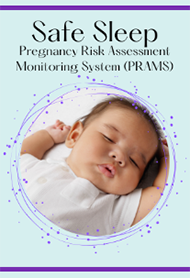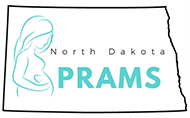Ask A Researcher
September 2022
Safe Sleep PRAMS Points

The Pregnancy Risk Assessment Monitoring System (PRAMS), is a collaborative surveillance project of the Centers for Disease Control and Prevention (CDC), North Dakota Department of Health (NDDOH) and the Center for Social Research (CSR) at North Dakota State University (NDSU). North Dakota began collecting state-specific, population-based PRAMS data in 2017.
Chelsey Hukriede, M.A., is a research specialist with the CSR and the Program Coordinator for PRAMS and SOARS (Study of Associated Risks of Stillbirth). Chelsey received her master’s degree in Sociology at University of North Dakota.
The North Dakota Pregnancy Risk Assessment Monitoring System (PRAMS) is a collaborative surveillance project of the Centers for Disease Control and Prevention (CDC), the North Dakota Department of Health, and the Center for Social Research at North Dakota State University (NDSU). PRAMS collects state-specific data on maternal attitudes and experiences before, during, and shortly after pregnancy, with the overall goal of reducing infant morbidity and mortality.
This article overviews safe sleep practices among mothers in North Dakota as summarized in the new PRAMS Points Safe Sleep dashboard. This dashboard was produced with annual data from the 2017 to 2020 North Dakota PRAMS surveys to analyze sleep practices utilized by mothers across the state. Ongoing surveillance efforts, like this dashboard, help to identify groups of women and babies at high risk for health problems, to monitor changes in health status, and to measure progress towards PRAMS’ overall goal in improving the health of all mothers and babies.
Safe Sleep Background
Approximately 3,500 babies in the United States die suddenly each year, including those from sudden infant death syndrome (SIDS), accidental suffocation and strangulation in bed, and other undetermined causes (1). Sleep-related infant deaths are the leading cause of infant death after the first month of life and the third leading cause of infant death overall (2). Even one baby death is too many so it is important to encourage safe sleep practices to help reduce the risk of sleep related infant deaths.
Past research has shown a 45 percent decline in sudden unexpected infant deaths (SUIDs) from 1990 to 1998 (3). This decline can be attributed to the 1992 American Academy of Pediatrics (AAP) recommendation that babies are placed on their backs to sleep and the National Institutes of Health Back to Sleep (now called Safe to Sleep) campaign that started in 1994. Since 1998 the SUID rate has declined less than 10 percent while the prevalence of babies being placed on their back to sleep has remained the same (3).
The AAP has since expanded their safe sleep recommendations to include the use of a firm sleep surface, room-sharing without bed-sharing, and the avoidance of soft objects and loose bedding. Even with these new recommendations, data from the National Infant Sleep Position (NISP) study found that the rate of bed-sharing doubled from 1993 to 2010 (7% to 14%) while the use of soft bedding declined by over a third (86% to 55%) (3).
Unsafe sleep practices such as the use of sleep surfaces not intended for babies (i.e., couch or arm chair) and stomach sleeping increase the risk of SUIDS. Studies also suggest that the risk of infant death increases when a baby’s head or face is covered by bedding or their sleep surface is shared with others (4). For example, in one study of the deaths of 119 infants, babies were most often found on their stomachs (61%), and on a sleep surface not intended for babies (76%). The baby’s head or face was covered by bedding in 29 percent of cases. A shared sleep surface was the case in 47 percent of deaths. While only 8 percent of deaths involved infants found alone, not on their stomachs, and with their head and face uncovered (considered to be utilizing safe sleep practices) (4).
ABC's of Safe Sleep
As mentioned above, the American Academy of Pediatrics (AAP) recommends a safe sleep environment that can reduce the risk of all sleep-related infant deaths: laying baby to sleep on their backs, the use of a firm sleep surface, room sharing without bed sharing, and the avoidance of blankets, toys or pillows in the baby’s crib (1).
In North Dakota, according to the 2017-2020 PRAMS survey, there has been a slight increase in the rate at which respondents reported their health care provider recommended safe sleep practices each year. Overall, from 2017 to 2020, nearly all PRAMS respondents were told by their health care provider to lay their baby down to sleep on their back (94%); a large majority were advised to place baby to sleep in a crib, bassinet, or pack-and-play (88%) and about what items should or shouldn’t go in their baby’s bed (85%); and just over half of all mothers received advice from their health care provider that their baby should sleep in the same room as them (57%).
See more in the dashboard's ABC's of Safe Sleep tab!
The best practices of infant safe sleeping as recommended by the AAP can be easily remembered if we think of them as the ABC’s of safe sleeping: babies should always sleep Alone, on their Back, and in a Crib.
I Sleep Safest Alone
The AAP recommends that babies sleep in their parents’ room, close to their bed, but on a separate sleep surface designed for babies for the first year of life. Placing the bassinet close to the parents’ bed so that their baby is within view and reach can help to facilitate feeding, comforting, and monitoring at night. Sleeping in the parents’ room but on a separate surface decreases the risk of SIDS by as much as 50 percent by preventing suffocation, strangulation and entrapment that could occur when a baby sleeps in an adult bed (1).
The percentage of North Dakota PRAMS respondents who reported that their new baby always sleeps alone increased from 58 percent in 2017 to 65 percent in 2019. A slight decline can be seen from 2019 to 2020 when only 57 percent of respondents reported always putting their baby to sleep alone. Overall, 77 percent (2017 to 2020) of mothers say their new baby always or almost always sleeps alone.
Explore more results by clicking button A in the dashboard’s ABC’s of Safe Sleep tab.
I Sleep Safest on my Back
Placing a baby to sleep on their back for every sleep is the single most effective action that parents/caregivers can take to lower a baby’s risk of SIDS (sudden infant death syndrome). Studies suggest that stomach sleeping may place an infant at higher risk of SIDS by increasing the probability that: the baby will re-breathe their exhaled breath leading to carbon dioxide buildup, experience airway obstructions, or interfere with body heat dissipation leading to overheating (5). Additionally, research has found that infants who slept on their backs are less likely than infants who sleep on their stomachs to develop ear infections, stuffy noses or fevers (5).
The majority of North Dakota PRAMS respondents follow safe sleep practices when they lay their baby down to sleep. Approximately 84 percent of moms laid their baby to sleep on their back (2017 to 2020) with less than 13 percent laying their baby to sleep on their side (8%) or stomach (5%). The rate of North Dakota PRAMS respondents who report always laying their baby to sleep on their back has remained relatively stable, from 83 to 86 percent from 2017 to 2020.
Explore more results by clicking button B in the dashboard’s ABC’s of Safe Sleep tab.
I Sleep Safest in a Crib
To best reduce the risk of sudden infant death syndrome (SIDS) and suffocation, infants should be placed on a firm sleep surface such as a mattress in a safety-approved crib, covered by a fitted sheet with no other bedding or soft objects. A firm surface is one that maintains its shape and will not indent or conform to the shape of the baby’s head when they are laid down to sleep. Soft mattresses could create an indentation and increase the chances of rebreathing or suffocation if the baby is placed on or rolls over onto their stomach. Soft materials or objects, such as pillows, quilts, or comforters, even if covered by a sheet, should not be placed under a sleeping baby. If a mattress cover to protect against wetness is used, it should be tightly fitting and thin (1).
Most PRAMS respondents in North Dakota adhere to safe sleep practices in regards to where their baby sleeps. Ninety-one percent of PRAMS respondents from 2017 to 2020 reported their baby most often sleeps in a crib, bassinet, or play yard and 77 percent of moms reported room sharing (their baby sleeps in the same room as them). However, over half of North Dakota PRAMS respondents (51 percent) put their new baby to sleep with a blanket, which is not considered a safe sleep practice. Meanwhile, 43 percent of moms follow safe sleep recommendations by using a sleep sack or wearable blanket instead.
Explore more results by clicking button C in the dashboard’s ABC’s of Safe Sleep tab.
Recommendations that babies sleep on their back, alone, on firm sleep surfaces that lessen the risk of entrapment or head covering have the potential to save many lives. Campaigns are needed to heighten awareness of these messages and of the risks of dangerous bed-sharing. Ongoing surveillance efforts can identify populations at risk for unsafe sleep practices, and help evaluate policies and programs to improve safe sleep practices. Health care providers and state-based and community-based programs can identify barriers to safe sleep practices and provide culturally appropriate counseling and messaging to help improve infant sleep practices.
References
(1) Moon, R. Y.; Darnall, R. A.; Feldman-Winter, L.; Goodstein, M. H.; & Hauck, F. R. (2016). SIDS and other sleep-related infant deaths: evidence base for 2016 updated recommendations for a safe infant sleeping environment. Pediatrics, 138(5). Retrieved from: https://doi.org/10.1542/peds.2016-2940.
(2) Bombard, J. M.; Kortsmit K.; Warner L; et al. (2018). Vital signs: trends and disparities in infant safe sleep practices – United States, 2009-2015. Morbidity and Mortality Weekly Report 2018; 67:39-46. Retrieved from: http://dx.doi.org/10.15585/mmwr.mm6701e1.
(3) Hirai, A. H.; Kortsmit, K.; Kaplan, L.; et al. (2019). Prevalence and factors associated with safe infant sleep practices. Pediatrics, 144(5). Retrieved from: https://doi.org/10.1542/peds.2019-1286.
(4) Kemp, J.; Unger, B.; Wilkins, D.; et al. (2000). Unsafe sleep practices and an analysis of bedsharing among infants dying suddenly and unexpectedly: Results of a four-year, population based, death-scene investigation study of sudden infant death syndrome and related deaths. Pediatrics, 106(3). Retrieved from: https://doi.org/10.1542/peds.106.3.e41.
(5) National Institute of Child Health and Human Development. Research on back sleeping and SIDS. Retrieved from: https://safetosleep.nichd.nih.gov/research/science/backsleeping.
(6) Pregnancy Risk Assessment Monitoring System. Prevalence of selected maternal and child health indicators for all pregnancy risk assessment monitoring system (PRAMS) sites, 2016-2020. Retrieved from: https://www.cdc.gov/prams/prams-data/mch-indicators/states/pdf/2020/All-Sites-PRAMS-MCH-Indicators-508.pdf.
PRAMS Information
More information about the PRAMS project and PRAMS data can be found at www.health.nd.gov/prams.
Explore the NEW PRAMS Points Safe Sleep Dashboard today!

Other PRAMS POINTS
• Pregnancy and Oral Health (May 2021)
• Gestational Diabetes (August 2022)
• Pregnancy and Diabetes (Coming Soon)
